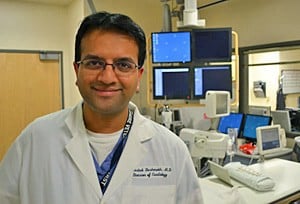Women More Likely to Have ‘Broken Heart Syndrome’
| 
Abhishek Deshmukh, M.D., a UAMS cardiology fellow, led the national study that determined women are 7.5 times more likely to experience “broken heart syndrome.”
Nov. 29, 2011 | A University of Arkansas for Medical Sciences (UAMS) study has found that women are 7.5 times more likely to experience “broken heart syndrome,” heart attack-like symptoms that occur during sudden or continuing stress.
The study of more than 7,000 broken heart syndrome cases, led by Abhishek Deshmukh, M.D., a cardiology fellow at UAMS, has attracted international media attention, including Time, the BBC, and the Washington Post. His results of the first large-scale study of the condition were announced at a recent American Heart Association conference in Orlando, Fla.
“I noticed that this was happening almost exclusively with women, so I wanted to learn more,” Deshmukh said of his inspiration for the study.
A national database with about 1,000 hospitals provided information on 6,229 broken heart syndrome cases in 2007. Only 671 of the patients were men. After adjusting for high blood pressure, smoking and other factors that can affect heart health, women were 7.5 times more likely to experience the syndrome than men.
Triggers for the syndrome include emotional breakups, death and sudden, major surprises, including good news, like winning the lottery. Such events cause the body to produce a rush of adrenaline and other stress hormones that cause the heart to swell quickly, impairing its function. The condition affects the heart’s rhythm and produces blood substances consistent with a heart attack, but unlike a classic heart attack, there is no artery blockage.
“When this occurs, it is exactly like having a heart attack,” Deshmukh said. “The EKG and blood tests suggest a heart attack, but heart catheterization reveals ballooning of the left ventricle and no blockages, which is usually present in more traditional heart attack cases.”
Patients typically recover, but Deshmukh’s study found that 2 percent died.
The medical term for broken heart syndrome is Takotsubo cardiomyopathy, a name given by Japanese doctors who first recognized the condition around 1990.
Deshmukh’s study found that the syndrome was three times more common in women older than 55 than in younger women. Women younger than 55 were 9.5 times more likely to experience it than men younger than 55.
Deshmukh said no one knows why women are primarily affected, but additional studies are planned.
One theory is that hormones play a role, he said. Another is that men have more adrenaline receptors on cells in their hearts than women do.